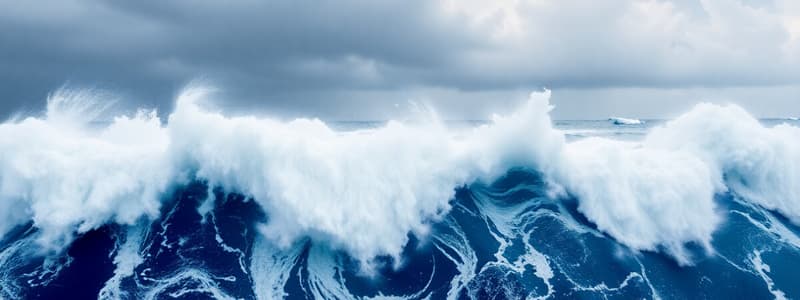Podcast
Questions and Answers
What is considered the most dangerous part of a hurricane?
What is considered the most dangerous part of a hurricane?
- Tornadoes
- Raining
- High Winds
- Storm Surge (correct)
What can be a consequence of the debris scattered by a hurricane?
What can be a consequence of the debris scattered by a hurricane?
- Strengthening of structures
- Improved air quality
- Spread of diseases (correct)
- Aid in storm prediction
Which phenomenon is most likely to occur when a hurricane makes landfall?
Which phenomenon is most likely to occur when a hurricane makes landfall?
- Landslides
- Fires
- Tornadoes (correct)
- Flooding
What precaution should people take during a hurricane?
What precaution should people take during a hurricane?
How high can storm surges reach during a hurricane?
How high can storm surges reach during a hurricane?
What equipment do 'Hurricane Hunters' use to collect data?
What equipment do 'Hurricane Hunters' use to collect data?
What is the primary factor that causes hurricanes to rotate differently in the northern and southern hemispheres?
What is the primary factor that causes hurricanes to rotate differently in the northern and southern hemispheres?
What is a common danger associated with heavy rain from hurricanes?
What is a common danger associated with heavy rain from hurricanes?
What should people do if emergency managers advise evacuation during a hurricane?
What should people do if emergency managers advise evacuation during a hurricane?
Which part of a hurricane is known for having the strongest winds and heaviest rains?
Which part of a hurricane is known for having the strongest winds and heaviest rains?
How is the strength of a hurricane typically assessed?
How is the strength of a hurricane typically assessed?
Which of the following conditions is NOT necessary for the development of a hurricane?
Which of the following conditions is NOT necessary for the development of a hurricane?
During which months does the Atlantic hurricane season typically occur?
During which months does the Atlantic hurricane season typically occur?
What is the maximum wind speed at which a storm is classified as a hurricane?
What is the maximum wind speed at which a storm is classified as a hurricane?
What happens to hurricane names after they have been used?
What happens to hurricane names after they have been used?
What other names are used for hurricanes in different regions?
What other names are used for hurricanes in different regions?
Flashcards
Hurricane
Hurricane
A powerful tropical storm with heavy rain and strong winds
Hurricane formation
Hurricane formation
Requires warm ocean water (26°C or above), moist air, and converging winds
Hurricane rotation
Hurricane rotation
Clockwise in the Southern Hemisphere, counter-clockwise in the Northern Hemisphere, due to the Coriolis Effect
Hurricane parts
Hurricane parts
Signup and view all the flashcards
Hurricane strength
Hurricane strength
Signup and view all the flashcards
Hurricane names
Hurricane names
Signup and view all the flashcards
Hurricane season
Hurricane season
Signup and view all the flashcards
Hurricane types
Hurricane types
Signup and view all the flashcards
Hurricane Storm Surge
Hurricane Storm Surge
Signup and view all the flashcards
Hurricane High Winds
Hurricane High Winds
Signup and view all the flashcards
Hurricane Debris
Hurricane Debris
Signup and view all the flashcards
Hurricane Tornadoes
Hurricane Tornadoes
Signup and view all the flashcards
Hurricane Flooding
Hurricane Flooding
Signup and view all the flashcards
Hurricane Hunters
Hurricane Hunters
Signup and view all the flashcards
Hurricane Evacuation
Hurricane Evacuation
Signup and view all the flashcards
Hurricane Safety
Hurricane Safety
Signup and view all the flashcards
Study Notes
Hurricanes: Characteristics and Impacts
- Hurricanes are intense tropical storms with heavy rain and powerful winds.
- They originate over warm ocean waters.
- Key ingredients for hurricane development: warm water (at least 26°C), moist air, and converging winds.
- Winds exceeding 119 km/h define a hurricane.
- Hurricanes rotate clockwise in the southern hemisphere and anticlockwise in the northern hemisphere due to the Coriolis effect.
- Hurricanes have three main parts: an eye (calm center), an eye wall (strongest winds and rain), and rain bands (outer spinning clouds).
Hurricane Structure and Measurement
- Hurricanes are also known as cyclones and typhoons, depending on their location.
- The World Meteorological Organization (WMO) names tropical storms alphabetically for better tracking.
- The Saffir-Simpson Hurricane Scale (1-5) measures hurricane intensity. Higher levels cause greater damage.
- Atlantic hurricane season: June 1st to November 30th (peak: early August to late October).
Hurricane Hazards
- Storm Surge: The most dangerous part, powerful winds drive seawater towards the shore. This causes flooding and can reach heights of over 6 meters and extend over 150km inland.
- High Winds: Damages homes, trees, roads, and other outdoor structures.
- Debris: Scattered waste, potential for injuries from sharp objects, and risk of disease spread.
- Tornadoes: Associated with landfall, causing severe destruction and potential for fatalities.
- Heavy Rainfall/Flooding: Can cause inland flooding of rivers, lakes and low-lying areas.
Hurricane Preparedness and Response
- Hurricane Hunters: Aircraft equipped for gathering data (temperature, pressure, wind speed/direction) directly within the storm.
- Evacuation: If advised to evacuate, do so immediately.
- Safety Precautions: Stay indoors during a hurricane, avoid low-lying flood-prone areas, leave mobile homes, use shelters or higher ground.
Studying That Suits You
Use AI to generate personalized quizzes and flashcards to suit your learning preferences.




